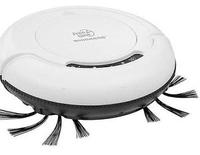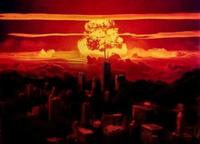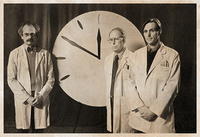-
Using pencil and paper to detect hazardous chemicals
Three students from Northwestern University have proven that pencils and regular office paper can be used to create functional devices that can measure strain and detect hazardous chemical vapors. The project originated during a discussion about the conductive properties of graphene, a one-atom thick layer of carbon that can be parsed from regular pencil lead.
-
-
Thumbnail-sized quantum cascade laser, tuning forks detect greenhouse gases
Human activities such as agriculture, fossil fuel combustion, wastewater management, and industrial processes are increasing the amount of nitrous oxide in the atmosphere. The warming impact of methane and nitrous oxide is more than 20 and 300 times, respectively, greater compared to the most prevalent greenhouse gas, carbon dioxide, over a 100-year period. Methane and nitrous oxide detection is crucial to environmental considerations. Scientists use a thumbnail-sized quantum cascade laser (QCL) as well as tuning forks that cost no more than a dime to detect very small amounts of nitrous oxide and methane.
-
-
The basis for a permanent deal: deep, verifiable changes to Iran’s nuclear program
A new study says that only broad and verifiable changes to Iran’s current nuclear program could serve as a basis for a permanent nuclear deal between Iran and the international community. Among the changes: reducing the number of Iran’s uranium-enrichment centrifuges from the current 19,500 to no more than 4,000, and limiting Iran to one enrichment site; converting the heavy-water reactor being built in Araq to a light-water reactor fueled by low-enriched uranium; and imposing a tight, intrusive inspection regime for at least twenty years.
-
-
Service lives of European nuclear power stations to be extended
Germany has decided to abandon nuclear energy – in what the Germans call Energiewende (energy turnaround) – but new nuclear power stations are being built on all sides of Germany and service lives for existing facilities on the territory of Germany’s neighbors are being extended. German nuclear scientists should thus continue to be involved in assessing the safety of the nuclear power stations in neighboring countries, especially so since the EU has launched its LONGLIFE project, which aims to extend the service life of existing reactors from forty to sixty or even eighty years.
-
-
Turkeys inspire smartphone-capable early warning system for toxins
Some may think of turkeys as good for just lunch meat and holiday meals, but University of California, Berkeley bioengineers saw inspiration in the big birds for a new type of biosensor which changes color when exposed to chemical vapors. This feature makes the sensors valuable detectors of toxins or airborne pathogens. The technology can be adapted so that smartphones can help analyze the color fingerprint of the target chemical. In the future, it could potentially be used to create a breath test to detect cancer and other diseases.”
-
-
Highly sensitive tactile e-whiskers for robotics, other applications

From the world of nanotechnology we have gotten electronic skin, or e-skin, and electronic eye implants or e-eyes. Now we are on the verge of electronic whiskers. Researchers have created tactile sensors from composite films of carbon nanotubes and silver nanoparticles similar to the highly sensitive whiskers of cats and rats. E-whiskers could be used to mediate tactile sensing for the spatial mapping of nearby objects, and could also lead to wearable sensors for measuring heartbeat and pulse rate.
-
-
Salmonella biofilms extraordinarily difficult, if not impossible, to kill
In the United States, an estimated million-plus cases of Salmonella occurs annually, with 23,000 hospitalizations and 450 fatalities reported each year. Researchers find that once Salmonella bacteria get into a food processing facility and have an opportunity to form a biofilm on surfaces, it is likely to be extraordinarily difficult, if not impossible, to kill it.
-
-
Carbon nanotube sponge helps in water clean-up
A carbon nanotube sponge capable of soaking up water contaminants, such as fertilizers, pesticides, and pharmaceuticals, more than three times more efficiently than previous efforts has been presented in a new study published today. The carbon nanotube (CNT) sponges, uniquely doped with sulphur, also demonstrated a high capacity to absorb oil, potentially opening up the possibility of using the material in industrial accidents and oil spill clean-ups.
-
-
Toxins-breathing bacteria to help industry, environment
Preliminary tests suggest that the bacteria could be used to remove these pollutants from the wastewater and protect the surrounding ecosystems. Buried deep in the mud along the banks of a remote salt lake near Yosemite National Park are colonies of bacteria with an unusual property: they breathe a toxic metal to survive. Researchers believe that this unusual organism may one day become a useful tool for industry and environmental protection – for example, the bacteria could be used simply to clean up the water, but it might also be possible for the bacteria to help humans recover and recycle the valuable elements in the water.
-
-
U.S. conducted bioweapon tests in Japan in early 1960s
The U.S. Army tested biological weapons in Okinawa, Japan in the early 1960s when the United States ruled the prefecture. U.S documents confirmed that the tests, conducted at least a dozen times occurred between 1961 and 1962. The test involved releasing rice blast fungus over rice paddies in order to measure the agent’s effect on production. With hundreds of millions of people dependent on rice as a staple food, failure of rice production could result in mass starvation. The fungus infects crops naturally, and experts estimate it destroys enough rice to feed sixty million people a year.
-
-
Aging natural gas pipelines leak under Washington, D.C. streets
More than 5,893 leaks from aging natural gas pipelines have been found under the streets of Washington, D.C., a team of researchers finds. A dozen of the leaks could have posed explosion risks, the researchers said. Some manholes had methane concentrations as high as 500,000 parts per million of natural gas — about ten times greater than the threshold at which explosions can occur.
-
-
NRC: storing spent nuclear fuel in cooling pools is safe
The nuclear reactors now in service in the United States were built with the assumption that the spent fuel would be removed from nuclear the facilities after a few years, but because the government has failed to provide a centralized place to store the spent fuel, utility companies have had to store an ever-growing quantity of it in spent fuel pools on the grounds of the facilities. Scientists argue that it would be safer to move some of the spent fuel into giant steel and concrete casks, where it can be stored dry, with no reliance on water, pumps, or filters to keep them cool. The nuclear industry and the NRC do not agree.
-
-
Surviving a nuclear explosion in your city

During the cold war, scientists modeled every imaginable consequence of a nuclear explosion. Michael Dillon, a Lawrence Livermore Lab mathematician, found a gap in the sheltering strategies for people far enough from ground zero to survive the initial blast but close enough to face deadly radioactive fallout. Dillon’s model’s addresses the most vulnerable people, those who found shelter from the blast in lightweight buildings, or buildings lacking a basement (these buildings are more easily penetrated by deadly radioactive dust). His recommendations: if adequate shelter is fifteen minutes away, people should remain in their initial, poor-quality shelter no longer than thirty minutes after detonation. If the better shelter is only five minutes away, however, individuals should move there immediately, leaving the closer but unsafe buildings altogether.
-
-
Iconic Doomsday Clock remains at five minutes to midnight

Bulletin of the Atomic Scientists: It is still five minutes to midnight — and much too close to doomsday. The minute hand of the Bulletin’s iconic Doomsday Clock has been at five minutes to midnight since January 2012. In explaining why the hand would remain so close to figurative doomsday, the Bulletin’s science and security experts focused on the failure of world leaders to take action which would reduce the possibility of catastrophe related to nuclear weapons and climate change.
-
-
New test for detecting newly emerging strains of drug-resistant superbug
Molecular assays for MRSA are used in active surveillance programs to identify colonized patients rapidly. Active surveillance is a proven strategy to reduce transmission in healthcare settings and it helps prevent infection in vulnerable patients. BD Diagnostics has received FDA clearance to market the BD MAX MRSA XT Assay for use on the BD MAX System. This is the second assay from BD Diagnostics capable of detecting newly emerging MRSA strains with the novel mecC gene.
-
More headlines
The long view
Keeping the Lights on with Nuclear Waste: Radiochemistry Transforms Nuclear Waste into Strategic Materials
How UNLV radiochemistry is pioneering the future of energy in the Southwest by salvaging strategic materials from nuclear dumps –and making it safe.
Model Predicts Long-Term Effects of Nuclear Waste on Underground Disposal Systems
The simulations matched results from an underground lab experiment in Switzerland, suggesting modeling could be used to validate the safety of nuclear disposal sites.
